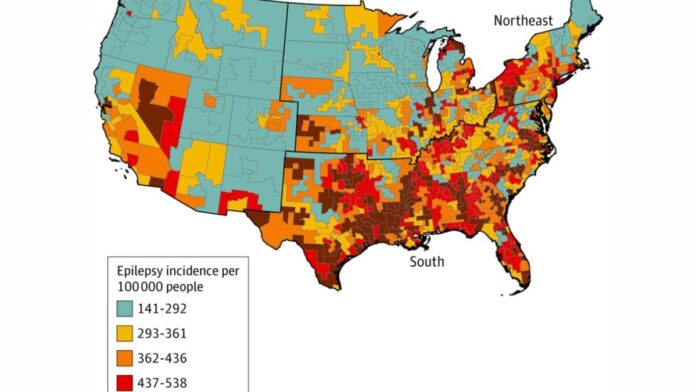Epilepsy isn’t something we usually associate with specific geographic regions, but new research suggests that’s an oversight—at least in the United States.
New research finds that certain parts of the U.S. have much higher rates of epilepsy than others. Researchers examined the Medicare data of Americans over 65 from across the country. Older adults were significantly more likely to be diagnosed with a new case of epilepsy if they lived in the southeastern U.S., they found. The findings suggest that this region might have unique risk factors that contribute to the neurological condition, such as hotter weather or larger health care disparities, the researchers say.
“Modifiable social and environmental conditions at the local level may contribute to epilepsy incidence among older adults and could help guide targeted prevention efforts,” the authors wrote in their paper, published this month in JAMA Neurology.
The epilepsy belt
Epilepsy is a disorder characterized by surges of unusual electrical activity in the brain, which then causes recurring seizures. There are many different causes and forms of epilepsy, but it’s known that certain groups of people are more likely to develop it, including older adults.
While previous research has shown that the prevalence of diagnosed epilepsy can differ between various regions of the world and the U.S., the scientists behind the new study say theirs is the first to map how often epilepsy affects older Americans at a national level.
The researchers are from the Houston Methodist Research Institute in Texas and Case Western Reserve University in Ohio. They analyzed Medicare claims data from 2016 to 2019, focusing on epilepsy cases newly diagnosed in 2019. All told, there were about 20,000 cases diagnosed that year. And the incidence rate of epilepsy varied significantly between regions of the U.S.
The highest rates were found in southeastern states like Louisiana, Mississippi, and Texas. The researchers also identified various factors that seemed to be correlated with epilepsy in the states along this “epilepsy belt”—as the researchers have dubbed it. Rates of insufficient sleep were higher in Louisiana, Alabama, and Georgia, for instance; southern states also had more days of extreme heat during the year (a heat index above 95 degrees); and states like Texas and Florida had higher uninsurance rates (younger people without insurance are less likely to see a doctor, which could then delay a timely diagnosis).
While some of these factors are thought to clearly increase epilepsy risk, like poor sleep, others have received less attention as potential causes.
“This is the first study documenting such a strong association between extreme heat and incident epilepsy in older adults across the U.S., highlighting the importance of climate change in emergency preparedness, especially given the graying of the population,” said study researcher Siran Koroukian, professor in the Department of Population and Quantitative Health Sciences at the Case Western Reserve University School of Medicine, in a statement.
Notably, this same region of the U.S. is also known to have higher rates of stroke, which has led researchers to call it the “stroke belt“. Since strokes are yet another major risk factor of epilepsy, that too is likely playing a part in causing new cases.
Areas of improvement
It’s estimated that about 3 million American adults are living with epilepsy. And while the condition isn’t currently curable in most cases, it can be effectively treated with medications, surgery, and managing potential triggers.
The researchers hope their findings can help improve efforts on epilepsy prevention and mitigation through various public health interventions in the areas of the country where people’s risk is highest.
“These may include improving sleep health, enhancing heat resilience, and reducing transportation and insurance-related barriers to care,” they wrote.

